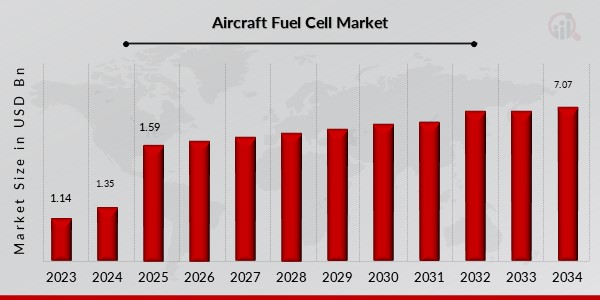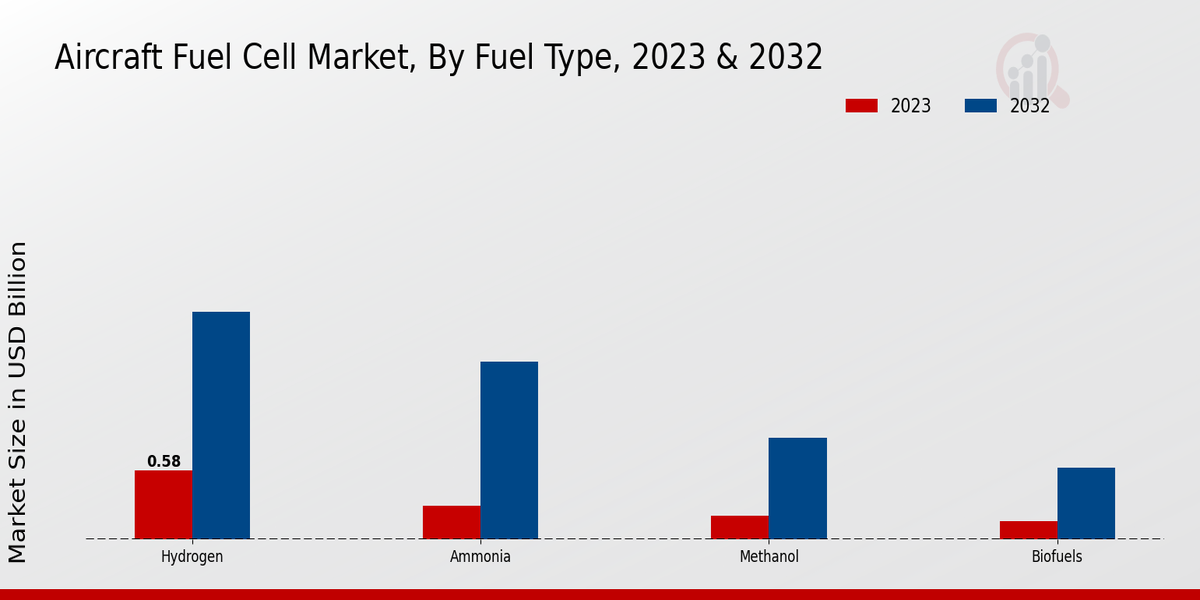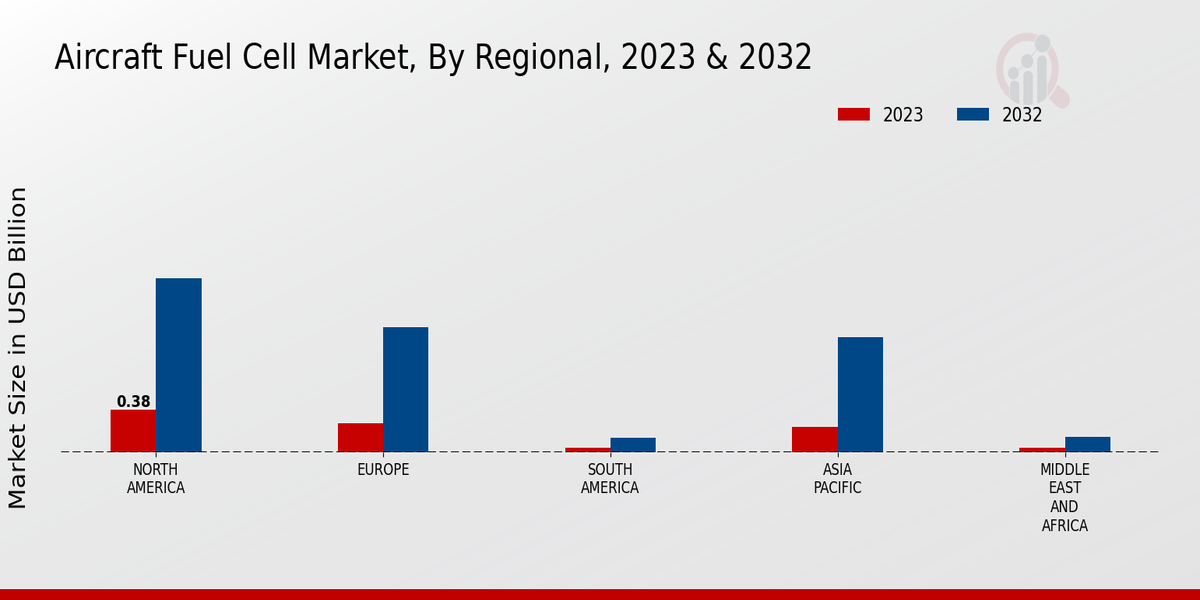Aircraft Fuel Cell Market Overview
The Aircraft Fuel Cell Market Size was estimated at 1.35 (USD Billion) in 2024. The Aircraft Fuel Cell Market Industry is expected to grow from 1.59 (USD Billion) in 2025 to 7.07 (USD Billion) by 2034. The Aircraft Fuel Cell Market CAGR (growth rate) is expected to be around 18.0% during the forecast period (2025 - 2034)

Source Primary Research, Secondary Research, MRFR Database and Analyst ReviewKey Aircraft Fuel Cell Market Trends Highlighted
Recent market trends in the Aircraft Fuel Cell Market reveal a surge in the adoption of hydrogen-powered aircraft, driven by Industry sustainability initiatives and advancements in fuel cell technology. This shift towards cleaner aviation is creating lucrative opportunities for market participants. Additionally, the demand for extended-range aircraft and the rising awareness of the environmental impact of traditional jet fuels are stimulating innovation within the market. Key market drivers include increasing government regulations and incentives, technological advancements in fuel cell efficiency, and partnerships between airlines and fuel cell manufacturers.
Aircraft Fuel Cell Market Drivers
Rising Demand for Fuel-Efficient Aircraft
The growing need for fuel-efficient aircraft is a major driver of the Industry Aircraft Fuel Cell Market Industry. Airlines worldwide are striving to reduce their operational costs and environmental impact, and aircraft fuel cells offer a promising solution. Fuel cells generate electricity through an electrochemical reaction between hydrogen and oxygen, producing water as a byproduct. This process is much more efficient than burning traditional jet fuel, leading to significant fuel savings.Moreover, fuel cells emit fewer pollutants, making them an environmentally friendly option for the aviation industry. As airlines become more aware of the benefits of fuel cells, the demand for aircraft equipped with this technology is anticipated to rise at a steady pace in the coming years.
Government Regulations and Incentives
Government regulations and incentives are another key factor driving the growth of the Industry Aircraft Fuel Cell Market Industry. Governments around the world are implementing stricter environmental regulations to reduce carbon emissions from the aviation sector. This has led to a growing interest in alternative fuels and technologies, including aircraft fuel cells. In addition, many governments are offering financial incentives to airlines that invest in fuel-efficient aircraft.These incentives can take the form of tax breaks, grants, and subsidies. As governments continue to push for a more sustainable aviation industry, the demand for aircraft fuel cells is expected to increase.
Advancements in Fuel Cell Technology
Advancements in fuel cell technology are also contributing to the growth of the Industry Aircraft Fuel Cell Market Industry. Fuel cell technology has improved significantly in recent years, with increased efficiency, reduced costs, and improved durability. These advancements are making fuel cells a more viable option for aircraft applications. Additionally, research and development efforts are ongoing to further improve fuel cell technology, which is expected to lead to even greater adoption in the aviation industry.
Aircraft Fuel Cell Market Segment Insights
Aircraft Fuel Cell Market Fuel Type Insights
The Industry Aircraft Fuel Cell Market segmentation by Fuel Type comprises Hydrogen, Ammonia, Methanol, and Biofuels. In 2023, Hydrogen dominated the market, accounting for nearly 60% of the Industry Aircraft Fuel Cell Market revenue. Its high energy density and zero-carbon emissions contribute to its dominance. Ammonia is projected to be the fastest-growing segment during the forecast period, driven by advancements in ammonia-powered fuel cell technology and its potential for sustainable aviation. Methanol is expected to hold a significant market share due to its cost-effectiveness and compatibility with existing infrastructure. Biofuels, derived from renewable sources, are gaining traction as a sustainable alternative to conventional jet fuels. Their increasing adoption is expected to drive the growth of the biofuels segment in the coming years.

Source Primary Research, Secondary Research, MRFR Database and Analyst Review
Aircraft Fuel Cell Market Application Insights
The Application segment of the Industry Aircraft Fuel Cell Market holds significant growth potential, with various aircraft types driving demand. Commercial Aircraft holds a substantial market share, contributing significantly to the overall revenue. This segment is driven by increasing air travel and demand for fuel-efficient aircraft to reduce operating costs. Military Aircraft is another key segment, with governments investing in advanced technologies for defense purposes. General Aviation Aircraft, including private jets and small passenger planes, also contribute to market growth, driven by rising demand for personal and business travel. The Industry Aircraft Fuel Cell Market segmentation provides insights into the specific requirements and opportunities within each application area, enabling manufacturers to tailor their products and services accordingly.
Aircraft Fuel Cell Market Cell Type Insights
The Industry Aircraft Fuel Cell Market is segmented by Cell Type into Proton Exchange Membrane Fuel Cells (PEMFC), Solid Oxide Fuel Cells (SOFC), Alkaline Fuel Cells (AFC), and Direct Methanol Fuel Cells (DMFC). Among these, PEMFC holds the largest market share due to its high power density, low operating temperature, and fast start-up time. PEMFCs are suitable for various aircraft applications, including unmanned aerial vehicles (UAVs), small aircraft, and commercial airliners. The increasing demand for fuel-efficient and environmentally friendly aircraft is driving the growth of the PEMFC segment.SOFCs are projected to witness significant growth in the coming years due to their high efficiency and ability to operate at higher temperatures. AFCs and DMFCs have niche applications in specific aircraft segments. The market growth for all cell types is driven by factors such as rising fuel prices, stringent environmental regulations, and government incentives for clean energy technologies.
Aircraft Fuel Cell Market Power Output Insights
The Industry Aircraft Fuel Cell Market is segmented into Low Power ( 100 kW), Medium Power (100 - 500 kW), and High Power (> 500 kW) based on power output. The Medium Power segment is expected to witness significant growth over the forecast period due to the increasing demand for fuel-efficient and environmentally friendly aircraft. This segment is projected to reach a valuation of USD 1.2 billion by 2024, growing at a CAGR of 19.5% during the forecast period. The Low Power segment is also expected to experience considerable growth, driven by the rising demand for small and medium-sized aircraft.The High Power segment is anticipated to have a moderate growth rate due to the limited number of large aircraft in operation. However, technological advancements and the growing focus on sustainable aviation are expected to drive the growth of this segment in the long run.
Aircraft Fuel Cell Market Regional Insights
The regional segmentation of the Industry Aircraft Fuel Cell Market offers insights into the market's geographic distribution and growth potential. North America is expected to dominate the market, driven by the presence of major aircraft manufacturers and airlines, as well as government initiatives to promote sustainable aviation. Europe follows closely, with a strong focus on research and development of fuel cell technology for aviation. The Asia-Pacific region is projected to witness significant growth, fueled by the increasing demand for air travel and the growing presence of low-cost carriers.South America and the Middle East and Africa regions are expected to contribute a smaller share to the overall market, but they present opportunities for growth as the aviation industry expands in these regions.

Source Primary Research, Secondary Research, MRFR Database and Analyst Review
Aircraft Fuel Cell Market Key Players And Competitive Insights
Major players in the Aircraft Fuel Cell Market industry are continuously investing in research and development to improve the efficiency and performance of their products. Leading Aircraft Fuel Cell Market players are also focusing on strategic partnerships and collaborations to expand their market reach and gain a competitive edge. The Aircraft Fuel Cell Market is expected to witness significant growth in the coming years, driven by increasing demand for sustainable and efficient aircraft fuel solutions. This growth is likely to attract new entrants into the market, leading to increased competition and innovation.A leading player in the Aircraft Fuel Cell Market industry is Plug Power Inc. The company offers a range of hydrogen fuel cell solutions for various applications, including aircraft. Plug Power Inc. has a strong presence in the North American and European markets and is actively expanding its operations in Asia-Pacific. The company's fuel cells are known for their high efficiency, durability, and reliability. Plug Power Inc. has partnered with several leading aircraft manufacturers to develop and integrate its fuel cell technology into new aircraft designs.A competitor to Plug Power Inc. in the Aircraft Fuel Cell Market is HyPoint Inc. The company specializes in the development and production of high-power-density hydrogen fuel cell systems for aviation and other applications. HyPoint Inc.'s fuel cells are designed to provide superior performance and efficiency compared to conventional fuel cells. The company has secured funding from several venture capital firms and is working with major aircraft manufacturers to commercialize its technology. HyPoint Inc. is expected to pose a significant challenge to Plug Power Inc. in the coming years as the Aircraft Fuel Cell Market continues to grow.
Key Companies in the Aircraft Fuel Cell Market Include
- Ballard Power Systems
- Air Product
- Iwatani
- Showa Denko
- Plug Power
- Doosan Fuel Cell
- Linde
- Nuvera Fuel Cells
- Ceres Power
- Hydrogenics
- Cummins
- Bloom Energy
- SAFT
- SFC Energy
- Praxair
Aircraft Fuel Cell Market Industry Developments
The Industry aircraft fuel cell market is projected to reach USD 4.3 billion by 2032, exhibiting a CAGR of 18.0% from 2024 to 2032. The rising demand for fuel-efficient and environmentally friendly aircraft, coupled with increasing investments in research and development, is driving market growth. The growing adoption of hydrogen-powered aircraft is further propelling the demand for fuel cells. Key players in the market include Airbus, Boeing, and Safran. Recent developments include the launch of Airbus's ZEROe concept aircraft, which utilizes hydrogen fuel cells for zero-emission flight. Additionally, the FAA's recent certification of Bye Aerospace's eFlyer 2, the first electric aircraft to receive type certification, signifies the growing acceptance of alternative fuel technologies in the aviation industry.
Aircraft Fuel Cell Market Segmentation Insights
Aircraft Fuel Cell Market Fuel Type Outlook
- Hydrogen
- Ammonia
- Methanol
- Biofuels
Aircraft Fuel Cell Market Application Outlook
Aircraft Fuel Cell Market Cell Type Outlook
- Proton Exchange Membrane Fuel Cells (PEMFC)
- Solid Oxide Fuel Cells (SOFC)
- Alkaline Fuel Cells (AFC)
- Direct Methanol Fuel Cells (DMFC)
Aircraft Fuel Cell Market Power Output Outlook
- Low Power ( 100 kW)
- Medium Power (100 - 500 kW)
- High Power (> 500 kW)
Aircraft Fuel Cell Market Regional Outlook
- North America
- Europe
- South America
- Asia Pacific
- Middle East and Africa
| Report Attribute/Metric |
Details |
| Market Size 2024 |
1.35(USD Billion) |
| Market Size 2025 |
1.59(USD Billion) |
| Market Size 2034 |
7.07(USD Billion) |
| Compound Annual Growth Rate (CAGR) |
18.0% (2024 - 2032) |
| Report Coverage |
Revenue Forecast, Competitive Landscape, Growth Factors, and Trends |
| Base Year |
2023 |
| Market Forecast Period |
2025 - 2034 |
| Historical Data |
2021 - 2024 |
| Market Forecast Units |
USD Billion |
| Key Companies Profiled |
Ballard Power Systems, Air Products, Iwatani, Showa Denko, Plug Power, Doosan Fuel Cell, Linde, Nuvera Fuel Cells, Ceres Power, Hydrogenics, Cummins, Bloom Energy, SAFT, SFC Energy, Praxair |
| Segments Covered |
Fuel Type, Application, Cell Type, Power Output, Regional |
| Key Market Opportunities |
Electrification of aircraft technological advancements government support an increased focus on sustainability rising demand for long-range aircraft |
| Key Market Dynamics |
Rising demand for fuel-efficient aircraft Government regulations promoting sustainable aviation Advancements in fuel cell technology Increasing investment in renewable energy Growing awareness of environmental impact |
| Countries Covered |
North America, Europe, APAC, South America, MEA |
Frequently Asked Questions (FAQ) :
The Industry Aircraft Fuel Cell Market is projected to reach a valuation of 1.59 USD Billion in 2025.
The Industry Aircraft Fuel Cell Market is anticipated to reach a valuation of 7.07 USD Billion by 2034.
The Industry Aircraft Fuel Cell Market is projected to grow at a CAGR of 18.0% from 2025 to 2034.
North America is expected to account for the largest market share in the Industry Aircraft Fuel Cell Market in 2024.
Commercial Aircraft is expected to account for the largest market share in the Industry Aircraft Fuel Cell Market in 2024.
Key competitors in the Industry Aircraft Fuel Cell Market include Airbus, Boeing, Safran, UTC Aerospace Systems, and Woodward.
Major growth drivers for the Industry Aircraft Fuel Cell Market include increasing demand for fuel-efficient aircraft, stringent environmental regulations, and advancements in fuel cell technology.
Challenges faced by the Industry Aircraft Fuel Cell Market include high production costs, safety concerns, and technological limitations.
Opportunities for the Industry Aircraft Fuel Cell Market include government incentives, technological breakthroughs, and partnerships between industry players.
Key trends in the Industry Aircraft Fuel Cell Market include the development of lightweight and durable fuel cells, the integration of fuel cells with other aircraft systems, and the adoption of fuel cells for unmanned aerial vehicles.

















